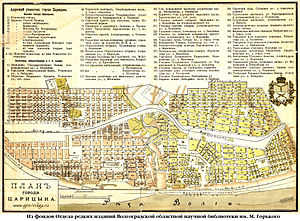Battle of Tsaritsyn
show This article may be expanded with text translated from the corresponding article in Russian. (August 2017) Click [show] for important translation instructions. |
This article includes a list of general references, but it remains largely unverified because it lacks sufficient corresponding inline citations. (January 2013) |
| Battle of Tsaritsyn | |||||||
|---|---|---|---|---|---|---|---|
| Part of the Southern Front of the Russian Civil War | |||||||
 A 1913 map of Tsaritsyn | |||||||
| |||||||
| Belligerents | |||||||
|
Supported by: |
| ||||||
| Commanders and leaders | |||||||
|
|
| ||||||
| Strength | |||||||
|
| At least 160,000[citation needed] | ||||||
| Casualties and losses | |||||||
| 130,000[citation needed] | 80,000[citation needed] | ||||||
The Battle of Tsaritsyn was a military confrontation between Bolshevik forces and the White Army during the Russian Civil War. It was for control of the significant city and port on the Volga River in southwestern Russia. The battle resulted in a Bolshevik victory.
Background[]
The battle started when White forces under Ataman Pyotr Krasnov laid siege to Tsaritsyn in the autumn of 1918, pushing back the Red Army defenders into areas surrounding the town on the west bank. The local Bolshevik leaders desperately called Moscow for reinforcements and arms, but received nothing other than orders to stand firm.
Battle[]
The city was saved by the actions of the local chairman of the military committee, Joseph Stalin. Stalin urged his comrades to continue fighting and disobeyed direct orders from Moscow by recalling forces from the Caucasus, nicknamed Zhloba's 'Steel Division'.[citation needed] These forces were able to attack the White forces in the rear and defeat them, saving Tsaritsyn for the Bolsheviks. Three major engagements then developed around the city afterwards during the entire duration of the battle but were likewise less successful than the first one.
White general Anton Denikin's troops temporarily took over the city in June 1919. Major Ewen Cameron Bruce of the British Army had volunteered to command a British tank mission assisting the White Army. He was awarded the Distinguished Service Order[2] for his bravery during the June 1919 battle for single-handedly storming and capturing the fortified city of Tsaritsyn, under heavy shell fire in a single tank; this led to the successful capture of over 40,000 prisoners.[3] The fall of Tsaritsyn is viewed "as one of the key battles of the Russian Civil War", which greatly helped the White Russian cause.[3] Noted historian B. H. Liddell Hart commented that Bruce's action is "one of the most remarkable feats in the whole history of the Tank Corps."[4]
However, Red Army forces under both Stalin and Voroshilov, strengthened by supplies and weapons that had recently arrived from Moscow, staged an all-out assault towards the city and retook it by January 1920. As a result, the defeated White Army, now in danger of destruction, then retreated towards the Crimean peninsula.
Aftermath[]
For these and later actions in the city of Tsaritsyn region, the city was renamed Stalingrad in 1925 to honor Stalin and his actions.[citation needed] About 17 years later the city would once again be a battlefield, this time for the decisive battle of the Eastern Front of World War II, the bloody Battle of Stalingrad. The city was renamed in 1961 to Volgograd by Nikita Khrushchev during his de-Stalinization reforms.[citation needed]
Gallery[]

Mitrofan Grekov's painting of an attack in Tsaritsyn

Grekov's painting of Stalin, Voroshilov and Shchadenko in the trenches of Tsaritsyn

Painting of the Red Army on their way to Tsaritsyn

White Army armoured train "United Russia" on its way towards the city, June 1919

Local citizens welcome Denikin and officers to the city on 1 July 1919

Denikin and Wrangel during a Tsaritsyn parade with Armed Forces of South Russia in July 1919
References[]
- ^ Damien Wright, Churchill's Secret War with Lenin: British and Commonwealth Military Intervention in the Russian Civil War, 1918-20, Solihull, UK, 2017, p. 397
- ^ Distinguished Service Order citation for Bruce in the 1920 London Gazette[permanent dead link]
- ^ Jump up to: a b Kinvig, Clifford. "Churchill's Crusade: The British Invasion of Russia, 1918-1920". Hambledon Continuum: 2006, p. 225; ISBN 9781847250216.
- ^ Liddell Hart, Basil. "The Tanks: The History Of The Royal Tank Regiment And Its Predecessors, Heavy Branch Machine-Gun Corps, Tank Corps And Royal Tank Corps, 1914-1945. Vol I". Cassell: 1959, p. 211.
- R. Overy, Why the Allies Won, London 1996
- Battles of the Russian Civil War
- Battles involving Russia
- Volgograd
- 1918 in Russia





